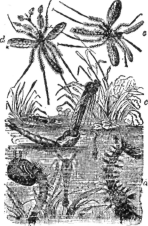MOSES I269 MOSQUITO
Description
This page of the book is from "The New Student's Reference Work: Volume 3" by Chandler B. Beach, Frank Morton McMurry and others.
MOSES I269 MOSQUITO
Mo'ses, the great lawgiver and leader of the Hebrew or Israelite nation, was born in Egypt, probably about the first half of the 14th century B. C. The Hebrews were under the power of the Egyptians, and lived in the eastern part of the Nile delta. His early life was spent at the court of Egypt, as the adopted son of Pharaoh's daughter, where he became learned in "all the wisdom of the Egyptians," Driven into the wilderness as a consequence of killing an Egyptian while protecting a fellow Hebrew from his cruelty, he spent 40 years as a keeper of flocks, until called back to lead his people out of Egypt. The story of the exodus, the 40 years' wandering in the wilderness, the giving of the law on Mount Sinai, the fixing of the ceremonies of the new religion, the patient endurance of waywardness and fickleness, until his solitary death and the unknown grave in Mt. Nebo, with only a view of the promised land to which he had led his people, is related in the first five books of the Bible, called the Books of Moses. See Moses, His Life and Times, by Rawlinson and Graetz's History of the Jews.
Mosquito {mus-kŕ't˘), a gnat-like, two-winged insect, the female of which punctures
the skin of man and animals and sucks blood. The names gnat and mosquito are often used inter-changeably,but gnat has a wider scope. The mosquito is a form of gnat, but there are others, like the gall - gnat and buffalo-gnat, to which the name of mosquito will not apply. The mosquito es are to be distinguished from all other kinds of gnats by having a fringe of scale - like hairs on the wings, and in American forms these are also found on the wing-veins. The female mosquito is the one that sings and bites ; the males are said to feed on the sweets of flowers. The apparatus for puncturing the skin and sucking blood consists of six slender pieces, united in a case and forming a sharp stylet. These pests are distributed not only in tropical and temperate regions but, during the warm season, in Lapland, Siberia, Canada and other cold countries. In Alaska they are remarkably abundant

life history op the mosquito (a) Larva, (b) Pupa, (c) Insect emerging. (d) Male Mosquito. (e) Female Mosquito.
and voracious. They abound in regions around the Lake of the Woods and drive hunters, horses and cattle to distraction with their bites. In the course of the year there are several generations. Some adults hibernate through the winter, and may be found in barns, cellars, cold garrets or under bridges. In the south the mosquito pest continues throughout the year. As a rule mosquitoes do not fly far, but they are carried by light, continued winds, and many are taken long distances on railroad trains The life-history of the common mosquito is as follows: The eggs, to the number of 400 or 500, are deposited by a single mosquito in the form of a float or raft in any standing water. The eggs soon hatch into wigglers or larvae, which feed upon decaying matter in the water. The wigglers breathe by an air-tube in the posterior part of the body, and it is necessary for them to come to the surface for air every two or three minutes. The larvŠ soon pass into a pupa-stage from which the perfect insect emerges. Mosquitoes have unusual interest to medical men, since it has been recently shown that they are connected with the spread of malaria, jungle-fever, Roman fever and yellow fever. The more common mosquito of the genus Culex does not carry malaria, but a closely-related form with spotted wings, belonging to the genus Anopheles, carries the contagion. Malaria is produced by a minute parasite (a protoz÷on), which lives within the red blood-corpuscles. When mosquitoes bite a person affected with malaria, they introduce into their own bodies many of these minute germs with the blood. There the parasites undergo a secondary development, and the infected mosquitoes, when they bite, carry the disease. This is the only known way of transmitting malaria. Yellow fever is also carried in a similar way. The disease is not transmitted by the clothing of the sick nor by contact with their bodies. To prevent the spread of these diseases it is important to get rid of the mosquitoes. Various means of combating them have been adopted, as draining marshy lands, introducing fish into the water, that feed upon the wigglers, and covering the surface of standing water with kerosene. The latter is the most effective. Oil dropped upon the water will spread as a film over it. When the wigglers come to the surface to breathe, the oil gets into their breathing-tubes and they are thereby killed. "In all mosquito-extermination," says Howard, "it must be remembered that they will breed successfully in any transient pool of water or in any receptacle where water is left standing for a week, no matter how small this receptacle. They may breed in collections of water in the hollows of old stumps, in old bottles or in old, discarded tomato cans. They breed profusely in rainwater barrels, in rain-water tanks, in old wells, even in cesspools where the adults are


